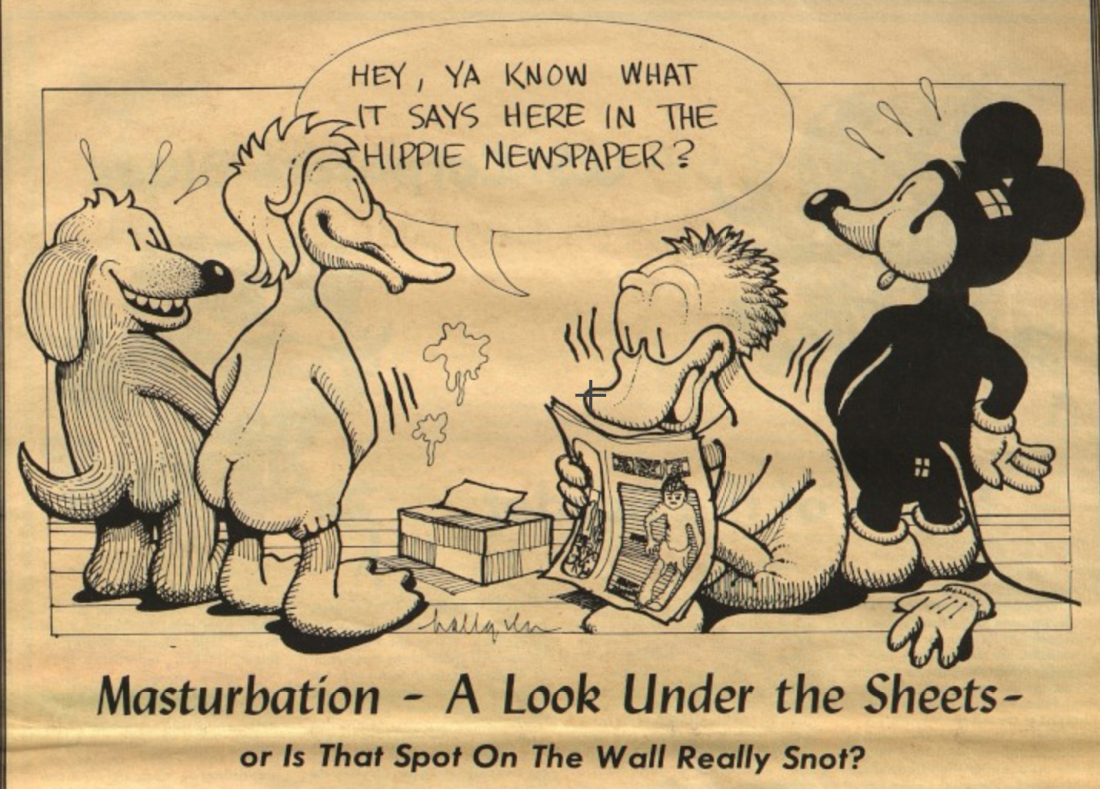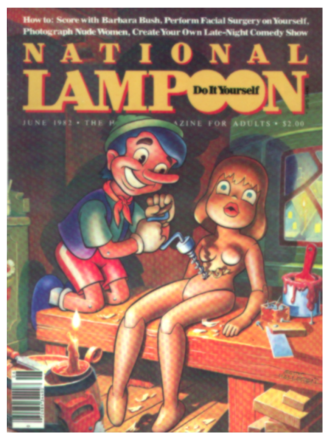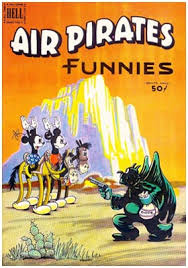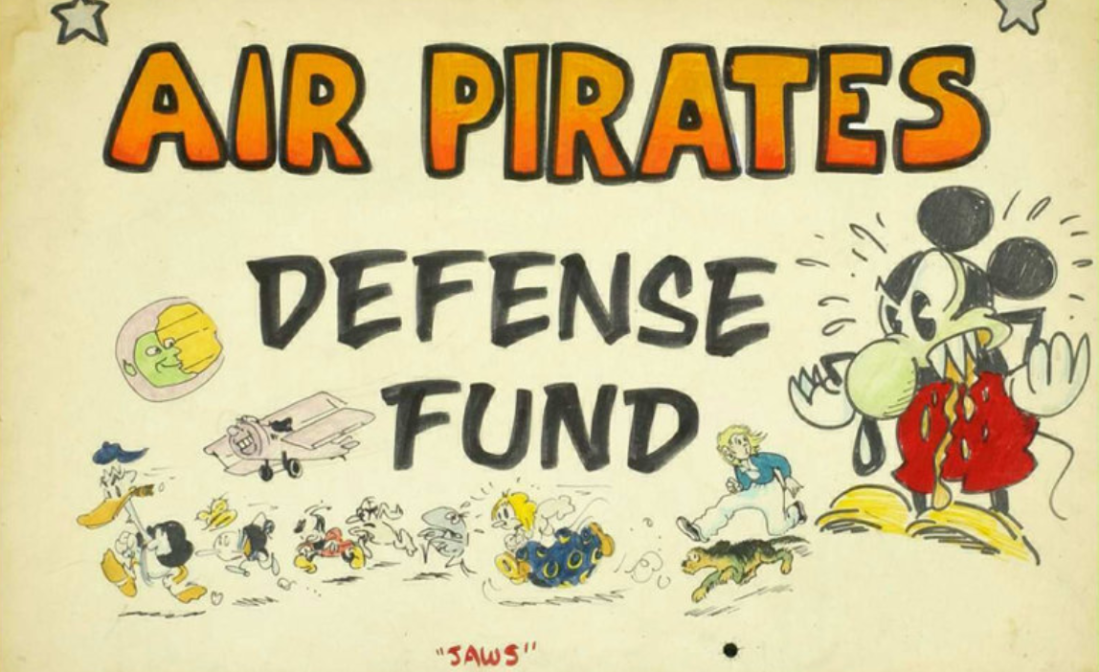COLE SANDHOFER
JOUR 340 Research Blog
 Hallgren The Tortise and the Hare No. 1, 1971
Hallgren The Tortise and the Hare No. 1, 1971
Gary Hallgren is a graphic artist, cartoonist and illustrator whose work has helped to define just how far parody is able to go. In 1969 his first illustrations appeared in The Northwest Passage, an underground newspaper published in Bellingham, Washington. His style drew heavily from that of past comic masters, often portraying recognizable and iconic characters partaking in adult behaviors such as sex and drug consumption. Hallgren would go on to join the Air Pirates, a group of underground cartoonist based out of San Francisco. Hallgren and the Air Pirates published two issues of a comic titled Air Pirates Funnies which parodied old-time comic strips and Walt Disney characters, as the group saw them as ripe for satire. Disney filed a lawsuit against the publication in 1971 for infringing on their copyrights. After 8 years of legal battles, the case finally ended in a settlement at the Supreme Court level in which both sides claimed victory. The case stands as a landmark in which the court ruled against a parody because of its offensiveness to the court’s moral sensibilities, and not because it failed to meet the legal criteria for protection.
Hallgren
Gary Hallgren was born October 28, 1945 and grew up in small towns around the Pacific Northwest. In a 2006 interview with Michael Hobbs, Hallgren said that he was inspired by comic strips he had read in newspapers growing up, and noted that some of the acknowledged masters of comic art were among his greatest influences. He published his first cartoons in his high school newspaper, and went on to study painting and design at Western Washington University, planning to become a commercial artist. After graduating, Hallgren would go on to start Splendid Sign Co. based out of Seattle. According to The Pirates and The Mouse by Bob Levin, Hallgren partnered with Doug Fast, an Art Institute of Seattle graduate, and their Art Nouveau and comic book style was a big hit in Seattle. They became known as the “hippie sign painters” and their work was visible throughout the city.
Hallgren began publishing works in The Northwest Passage, a counter-culture underground newspaper that was published in Bellingham from 1969 until 1986. The Passage stood out from other underground tabloids of the time due to its eye-catching design and graphic content, which employed the help of numerous artists in the area under the art direction of Michael Carlson. Hallgren published works in the Passage in which he began to play around with icons of popular culture, a style that he would later come to be known for.
 Hallgren cartoon from The Northwest Passage 7/8/1969
Hallgren cartoon from The Northwest Passage 7/8/1969
Hallgren’s parodies and illustrations have since been featured in publications such as Time, The New York Times, The Wall Street Journal, National Lampoon, Mad and Marvel Comics.
 Hallgren National Lampoon Cover, 1983
Hallgren National Lampoon Cover, 1983
Air Pirates
It was Hallgren’s lettering work on the side of a van that initially caught the attention of rebel cartoonist Dan O’Neill. O’Neill was the founder of an underground collective of comic artist known as the Air Pirates, which began a crusade to tackle what they viewed as symbols of conformist hypocrisy in American culture. The Pirates were a group of 5 artists made up of O’Neill and Hallgren along with Bobby London, Shary Flenniken and Ted Richards, who all lived together in a warehouse in San Francisco.
According to O’Neill in the 1988 documentary Comic Book Confidential, “The Air Pirates was a bizarre concept to ‘pirate the air’ or steal the media… let’s attack a corporation, and since we were cartoonist, the logical thing was Disney. You couldn’t criticize anything, because if you drew a mouse, or a so-called parodied version, parody had been weakened to a point where it loses its shock. If I want to draw Ronald Reagan, and i’m forced to draw somebody that looks like someone else, then it’s not him. So nobody gets the joke. Parody means to me, that you get the exact image and you turn it inside out.”
 Air Pirates Funnies Vol. 1, July 1971
Air Pirates Funnies Vol. 1, July 1971
 Air Pirates Funnies Vol. 2, August 1971
Air Pirates Funnies Vol. 2, August 1971
It was this sentiment that drove the Air Pirates to not only publish comics depicting characters similar to those of Disney engaging in promiscuous and deviant acts, but to actually refer to them by the names Disney had given them.
“Pop art can be about more than art or culture,” Hallgren said in an artist’s statement. “It can be about that most universal of themes: the human condition. Familiar newspaper comics characters can carry much symbolism on their black-and-white backs after being infused with the gravitas of easel painting.”
Disney lawsuit
In 1971, The Disney Corporation, less than thrilled by the first-amendment crusaders, sued O’Neill and his associates, alleging that they infringed on their copyright, trademark and engaged in unfair competition, trade disparagement and interference with Disney’s business.
A commentator on the case said, “The Air Pirates was an ‘underground’ comic book which had placed several well-known Disney cartoon characters in incongruous settings where they engaged in activities clearly antithetical to the accepted Mickey Mouse world of scrubbed faces, bright smiles and happy endings. It centered around a rather bawdy depiction of the Disney characters as active members of a free thinking, promiscuous, drug ingesting counterculture.”
 Hallgren unpublished High Times cover, 1980
Hallgren unpublished High Times cover, 1980
According to a case summary of the ruling, after balancing the interests of free speech and press versus “encouraging creation by protecting expression” of ideas as reflected in the Copyright Clause of the Constitution, the district court held that the First Amendment did not protect Air Pirates Funnies and in a preliminary injunction, the Air Pirates were found guilty and fined to $190.000 each.
In 1974 the district court granted summary judgment to O’Neill because the issues were “purely legal and ripe for decision”. O’Neill had founded of the Mouse Liberation Front (MLF) after the lawsuit began, and had generated a large amount of press coverage of the case, and in 1979 Disney decided to drop the fines if O’Neill stopped publishing images of Disney characters.
“We fought back, and that maybe was the precedent.” O’Neill commented on his role in defending first-amendment rights. “Because we started off with a hopeless condition, and if we were going down in flames, we might as well hit something big.”
“Knowing what I know now, I would have handled things differently.” Hallgren said in his interview with Hobbs. “But, I would do it all again.”
 Air Pirates Defense Fund Fundraising Poster, Early 1970’s
Air Pirates Defense Fund Fundraising Poster, Early 1970’s
Sources: